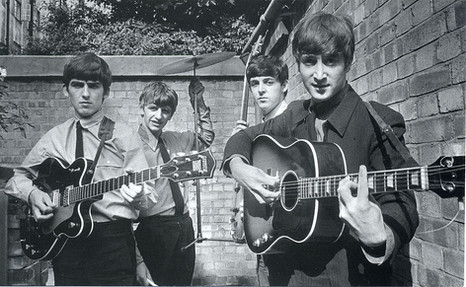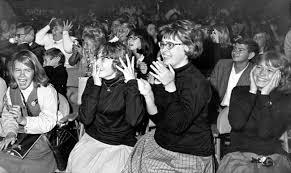The Beatles: Eight Days A Week—The Touring Years:“We just wanted to play”
- eclectic Stefan

- Oct 28, 2021
- 5 min read
Updated: Jul 11

For many people, ‘The Beatles’ says it all. Innovative recordings, prolific composers, revolutionary musicians, astounding performers, and cultural icons. For others, The Beatles are a vague memory of Paul McCartney’s first band. Still others will say, The Beatles? Who? At the expense of making a Sixties’ reference to my generation, The Who is not The Beatles. The Who is an entirely different Sixties band.
Director Ron Howard has crafted a film that seeks not to idolise The Beatles and their achievements with undue reverence. He sensed a story that would delve into how a band that started, according to Paul McCartney, as “a good laff”, devolved to become a victim of its success.
Compiling and structuring historic footage of The Beatles’ early performances and their offbeat humour and outspoken jovial manner, The Beatles: Eight Days A Week—The Touring Years portrays how success nurtured fame and, in its wake, fame turned The Beatles into commodities and objects of adoration to the detriment of their individuality and their music. They courted success and found fame. What started out as ‘simple’ had a complicated end.
They jested that they wanted to go “to the toppermost of the poppermost”. They achieved that in abundance, mainly through their live performances using rudimentary sound systems, sometimes channeled through public address systems in baseball parks; minimal security and the deafening roar of Beatlemania and the pursuit by fans of their admired ‘moptops’.
The Beatles honing their musical skills & exuberant personalities by playing tirelessly in clubs in Hamburg & Liverpool
The Beatles sought and gained success by playing clubs for 8 hours straight night after night in Hamburg and The Cavern in Liverpool, and then sought to escape the fame that imprisoned them. They scaled the height of their popularity when Beatlemania erupted and was let loose on the world of pop and rock music and society at large. They were labelled as a “menace to society”. This is The Beatles before they recorded their landmark albums Rubber Soul and Sgt. Pepper's Lonely Heart's Club Band.
“We just wanted to play” The Beatles
Unfortunately, The Beatles’ music was drowned out by the screaming fans in venues that filled stadiums of more than 50,000 people, including being rushed by 7,000 fans at a concert in Altamont. They played energetically but couldn’t hear each other play.

The Beatles live at Shea Stadium, New York: Energy & a driving beat
Watching and listening to their live performances in this movie highlights how synched, furious, and hard-driving they were as musicians. They rocked out with the best. The sound systems and crowd noise defeated them but their musicianship was rock solid.
When it all became too much, John Lennon reflected that when he sang the lyrics and the title of the song Help!, he meant it. He, along with Paul, George and Ringo had lost the joy of music. The fans, the hysteria, and the head-on impact it had on their music got bigger, then got crazy.
“No one prepared for this. It was without precedent. Larry Kane, journalist
Beyond the riotous audiences, there were forces at work that defined who George, Paul, Ringo and John were as part of The Beatles and as creative individuals. Their influence beyond the blaring decibels of shrieking fans was as landmark as their recordings.
Actor Whoopi Goldberg recounted how, as a teenager, The Beatles’ music spoke to her in a way that was, to use her word, “colourless”. The Beatles enabled her to say, “I am my own person and I can be who I am.”
“We played to people. Not these people or those people. Just people.” Ringo
The Beatles themselves insisted in their contracts that they would not perform in front of segregated audiences. The Beatles were agents of social change. They defined the time in which they lived, performed and existed socially and creatively. The Vietnam War, Muhammed Ali, race riots, segregation, the assassination of JFK and cultural awareness marked their thinking and the creative endeavours that epitomised that thinking. They were sensitive to other people and the impact of society’s judgements about social structures and prejudices.
Remember, this was 1964, 1965, and 1966. In musical, cultural, social and popularity terms, there had never been anything like The Beatles before, not even when you put Elvis into the picture.
But there was always their music. Their surrender to the impossibility of live performances anaesthetised their feelings about concerts and touring.
On the plus side, by giving up live performances they concentrated on the joy of writing, recording and playing with the technology available to them in the studio. That, in turn, resulted in and gave us, their listening audience, the innovative music on Sgt Pepper’s Lonely Hearts Club Band, The Beatles (The White Album), Abbey Road and Let it Be.

Mikal Gilmore, Rolling Stone, 2017
Six writers offer their perspectives, The Conversation, 2017
Through their years of performing live at venues in Hamburg and The Cavern, The Beatles became astoundingly good musicians. When you add their proclivity for songwriting, The Beatles, at their peak, would have been magical on stage.
Their final concert on the rooftop of The Beatles’ Apple Headquarters on Saville Road in London testifies to that notion.

Still image from The Beatles' Rooftop Concert (1969)
Although the impossibility of The Beatles in concert today is obvious for a number of reasons, imagine what an incredible tour it would have been if the Beatles could have performed live, including the songs, such as Strawberry Fields Forever, Rain and Tomorrow Never Knows, that were highly engineered and manipulated as studio recordings, and how The Beatles would have interpreted them live in a concert setting with an audience of fans who wanted to listen to the music rather than scream and shout.
The Beatles: Eight Days A Week—The Touring Years is the study of a phenomenon. As a social document, as a musical statement and as a personal journey, the film is interesting and thought-provoking. If you’re a Beatles’ fan, that adds another level to the movie.
Incredible band. Incredible musicians. Incredible individuals. Incredible documentary.

WATCH:
Director: Ron Howard
"I loved it, yeah, yeah, yeah, yeeeeeeeeah"
Eclectic Stefan
Official Trailer The Beatles: Eight Days A Week—The Touring Years
FILM EXTRAS: The Beatles Act Naturally

A Hard Day's Night (1964)
WATCH: A Hard Day's Night
A Hard Day's Night's madcap and anarchic film style is regarded as a forerunner of music video clips seen in shows such as Countdown (Australia), MTV (USA) and Rage (Australia).
Official Trailer A Hard Day's Night (1964)

Yellow Submarine (1968)
WATCH: Yellow Submarine
Yellow Submarine is a 1968 animated musical film inspired by the music of the Beatles and directed by animation producer George Dunning. The film received widespread acclaim from critics and audiences alike, in contrast to the Beatles' previous film venture Magical Mystery Tour. Half a century after its release, it is still regarded as a landmark of animation. Yellow Submarine is a cross between fabulous animation, psychedelia and surrealism matched with a soundtrack of Beatles' songs. John Lennon later said: "I think it's a great movie; it's my favourite Beatle movie. Sean loves it now, all the little children love it."
Official Trailer Yellow Submarine




























